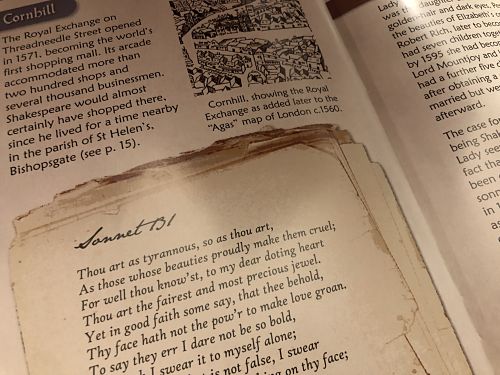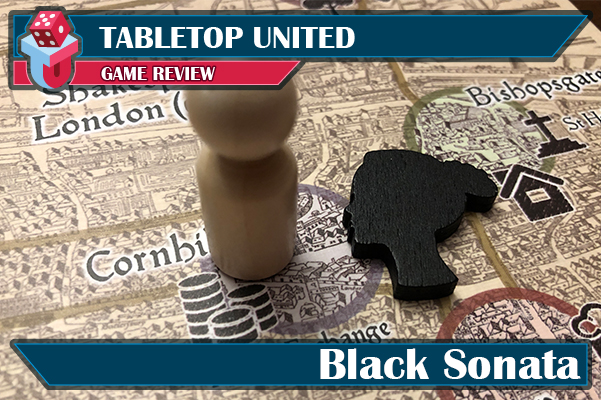
Wherefore Art Thou? A Black Sonata Review
Designer: John Kean
Artist: John Kean
Publisher: TGG Games
Year Published: 2017
No. of Players: 1
Ages: 12+
Playing Time: 20-30 minutes
Main Mechanic / Theme: Hidden Movement, Push Your Luck, Solo / Renaissance
Take a stroll through Shakespear's London and discover the identity of his mysterious muse.
Find more info on BoardGameGeek.com
Overview:
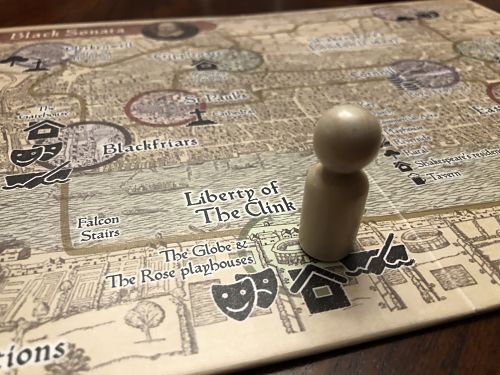
Centuries of historians have failed to identify the mysterious muse mentioned in Shakespeare’s sonnets. Black Sonata takes you through a solo-only journey in Shakespeare’s London, circa 1600s, with hidden movement and deduction as you strive to be the first to identify this mysterious dark lady.
Gameplay and Mechanisms:
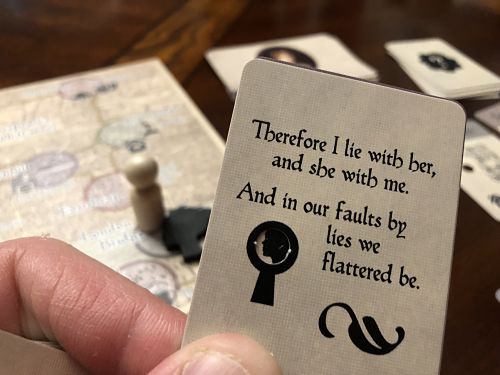
You found her! You get a clue.
You may wonder how a solo game can use hidden movement. Don’t worry, I asked the same thing. And while I love hidden-movement games, I was skeptical about its implementation. However, I am quite pleased with Black Sonata's gameplay.
The designer, John Kean, pulls off the hidden-movement mechanism by utilizing a special deck that simulates the movement of the mysterious woman. By moving from location to location, and seeing hints of where the lady might be, you can deduce the movements until you are certain you are in the right place. When you are, you can search the location for the lady by using a “key” card (i.e. an area-specific card with a little hold in it—a key hole—that will aid your search). If successful, you gain a clue card, which shows three specific symbols, and identifies how many of those symbols appear on the specific card you are seeking.
Of course, each card suit has two mysterious ladies, so despite knowing what is on a type of card, you must still deduce which card has those symbols on it. Also, by doing a Search action, you replace one of the hidden movement cards with a “fog” card, making successive movements more difficult when the card comes around again. The card you remove from the deck is placed over the key card of your current location. If the lady’s silhouette shows up in the key hold, you’ve found her! And you collect a clue card from the clue deck (i.e. an unused Dark Lady card), which will give you some hints as to what symbols are on the card you’re trying to deduce. If the lady’s silhouette is not showing up in the key hole, you are in the wrong spot and no clue is coming for you.
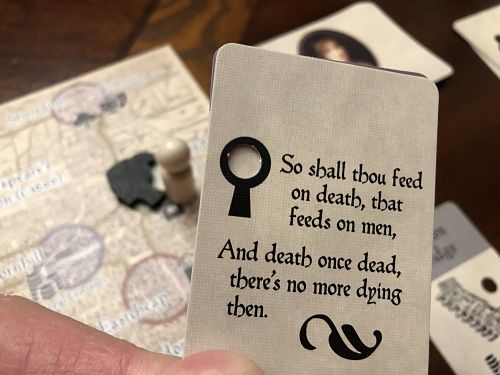
Nobody's home. No clue for you!
The fog cards are used as action cards as well. Actions can be good for you or bad for you, but you won’t know until you play it. So it’s a risk, but it could pay off (it’s done me in more times than helped, but I knew the risk going into it). That is also a neat aspect of the game.
There is a built-in timer in the movement deck, consisting of a card with four numbers on it (0-3), that is rotated and/or flipped each time you reveal it, indicating how many more times you can go through the deck before the game ends.
In order to win the game, you must commit three clue tokens to the board that you think match those on the card of your Dark Lady. If even one is wrong, you lose. If you get all three correct, you win! The deduction process is tricky, and I’m usually down to one of my last turns before I can finally figure out which tokens go to my card. And, sometimes, I’m still wrong. It’s an enjoyable loss, and I do love that in a game.
The hidden movement and deduction are melded marvelously to make this solo game actually work, and work well. I was quite impressed with how well the hidden movement worked, and while I’ve come to anticipate certain moves, I’m still known to be wrong on occasion (shocking, I know). It’s a fun puzzle, and a great deduction game you can blitz through relatively quickly on your own.
Theme, Artwork, et al.
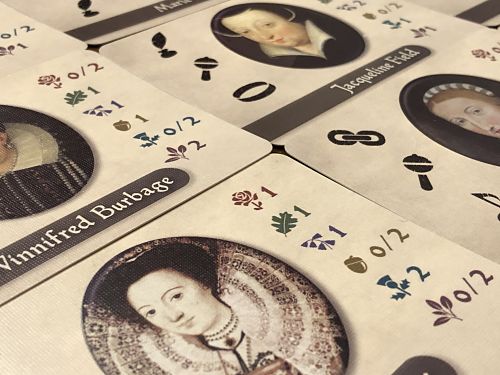
The theme of the game is pretty basic (good ol' Bill Shakespeare), but for an English nerd like me, it was practically perfect. Shakespeare’s 1600-era London was illustrated using an old map of the area, and the cards depicting Shakespeare’s possible muses were likewise historical in nature.
Running around London was a lot of fun, as I was able to retrace the bard’s steps in a way I hadn’t been able to do previously. I thought the theme and art worked well together, as well as with the gameplay and mechanisms of play.
What Worked:
I’ve said it once and I’ll say it again—the hidden-movement mechanism in solo play worked well! The use of a deck for this mechanism was a great idea. Likewise, the various symbols on the board make it easy to see where the muses could be running to, but still provide enough options to make you think about the possibilities.
While this next bit may not necessarily reflect the game itself, I appreciate how a lot of history and background is included in a separate booklet. I’m an English teacher by profession (well, getting my master’s degree for it as of this writing), and I really love Shakespeare’s works, so between the game itself and the history discussed, I’m really enjoying it. In fact, I’m going to see how I can incorporate this game into my classroom (when I get one, of course).
Final Thoughts:
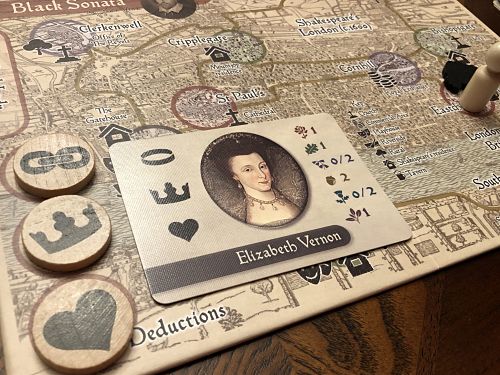
So close! But not close enough to win.
Black Sonata is a devious hidden-movement and deduction game for one player. If you’ve played other hidden-movement games, such as Specter Ops, you will already be familiar with the concept; however, Black Sonata takes away the sneaky player decisions and uses a deck (that can be arranged in various—but specific—ways) to simulate that other player. If you enjoy puzzle games, solo games, and/or hidden-movement games, this one is a good option.
Personally, I enjoy Black Sonata, and will continue playing it for quite some time, I expect. I do find the game can be somewhat predictable after a while. That said, despite that feeling, it doesn’t mean I win. On the contrary, I still lose despite feeling like I know what’s about to come. But that’s part of the game—anticipating the Dark Lady’s next move(s). Plus, there are various difficulty levels to play with, so you can increase or decrease the difficulty as you desire. So far I’ve only played on the normal difficulty, but when I’m ready for a bigger challenge, I have options.
In the end, I’m a fan of Black Sonata. I love that it’s strictly a solo game, and that it incorporates one of my favorite mechanisms in it. Still, it’s not my most-favorite solo game, and there are still a number of games I’d probably play over this one for a solo experience. However, it does provide fun use of deduction and hidden movement, and when I want that but don’t have (or want) other players to sit down with, this is an easily accessible game I can come to for a quick fix and play multiple times in a single sitting. It’s good, of that there is no doubt. Again, I’m happy to have will always keep it around.
Benjamin Kocher

Benjamin hails from Canada but now lives in Kentucky with his wife and kids. He’s a certified copyeditor and a freelance writer and editor, covering everything from board game rule books to novels. An avid writer of science fiction and fantasy, it comes as no surprise that his favorite board games are those with rich, engaging themes. He is a reviewer for Board Game Atlas and runs his own site, Board Game Immersion, where he focuses on storytelling within games. When he’s not writing or playing games, Benjamin loves to play ultimate Frisbee, watch and play rugby, and read the most epic fantasy books available. Follow him on Twitter @benjaminkocher and Instagram @benjamin_kocher. You can also read his board game inspired fiction at Board Game Immersion.
